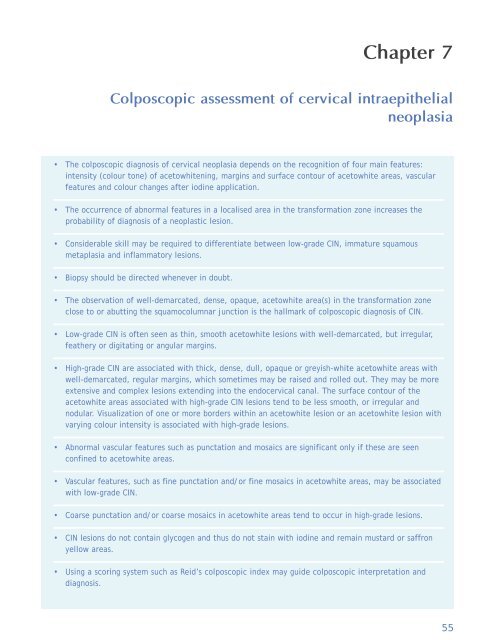Colposcopy and Treatment of Cervical Intraepithelial Neoplasia - RHO
Colposcopy and Treatment of Cervical Intraepithelial Neoplasia - RHO
Colposcopy and Treatment of Cervical Intraepithelial Neoplasia - RHO
Create successful ePaper yourself
Turn your PDF publications into a flip-book with our unique Google optimized e-Paper software.
Chapter 7<br />
Colposcopic assessment <strong>of</strong> cervical intraepithelial<br />
neoplasia<br />
• The colposcopic diagnosis <strong>of</strong> cervical neoplasia depends on the recognition <strong>of</strong> four main features:<br />
intensity (colour tone) <strong>of</strong> acetowhitening, margins <strong>and</strong> surface contour <strong>of</strong> acetowhite areas, vascular<br />
features <strong>and</strong> colour changes after iodine application.<br />
• The occurrence <strong>of</strong> abnormal features in a localised area in the transformation zone increases the<br />
probability <strong>of</strong> diagnosis <strong>of</strong> a neoplastic lesion.<br />
• Considerable skill may be required to differentiate between low-grade CIN, immature squamous<br />
metaplasia <strong>and</strong> inflammatory lesions.<br />
• Biopsy should be directed whenever in doubt.<br />
• The observation <strong>of</strong> well-demarcated, dense, opaque, acetowhite area(s) in the transformation zone<br />
close to or abutting the squamocolumnar junction is the hallmark <strong>of</strong> colposcopic diagnosis <strong>of</strong> CIN.<br />
• Low-grade CIN is <strong>of</strong>ten seen as thin, smooth acetowhite lesions with well-demarcated, but irregular,<br />
feathery or digitating or angular margins.<br />
• High-grade CIN are associated with thick, dense, dull, opaque or greyish-white acetowhite areas with<br />
well-demarcated, regular margins, which sometimes may be raised <strong>and</strong> rolled out. They may be more<br />
extensive <strong>and</strong> complex lesions extending into the endocervical canal. The surface contour <strong>of</strong> the<br />
acetowhite areas associated with high-grade CIN lesions tend to be less smooth, or irregular <strong>and</strong><br />
nodular. Visualization <strong>of</strong> one or more borders within an acetowhite lesion or an acetowhite lesion with<br />
varying colour intensity is associated with high-grade lesions.<br />
• Abnormal vascular features such as punctation <strong>and</strong> mosaics are significant only if these are seen<br />
confined to acetowhite areas.<br />
• Vascular features, such as fine punctation <strong>and</strong>/or fine mosaics in acetowhite areas, may be associated<br />
with low-grade CIN.<br />
• Coarse punctation <strong>and</strong>/or coarse mosaics in acetowhite areas tend to occur in high-grade lesions.<br />
• CIN lesions do not contain glycogen <strong>and</strong> thus do not stain with iodine <strong>and</strong> remain mustard or saffron<br />
yellow areas.<br />
• Using a scoring system such as Reid’s colposcopic index may guide colposcopic interpretation <strong>and</strong><br />
diagnosis.<br />
55
















